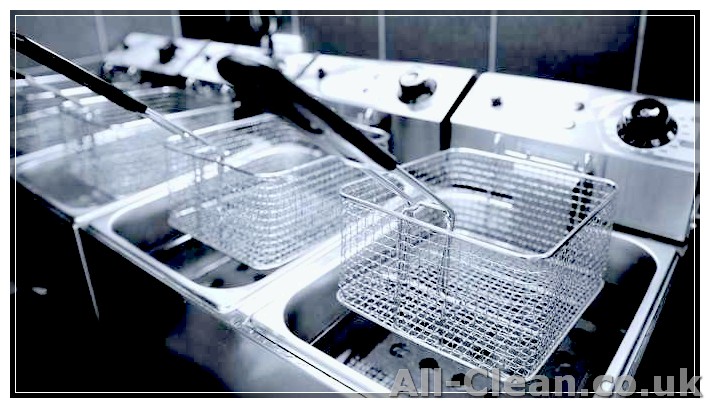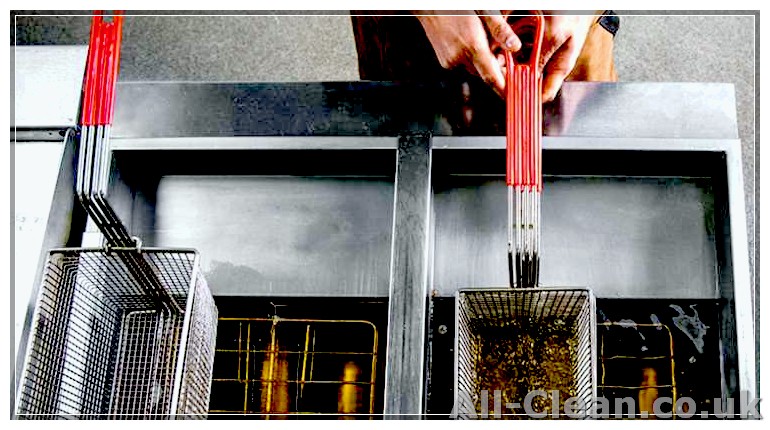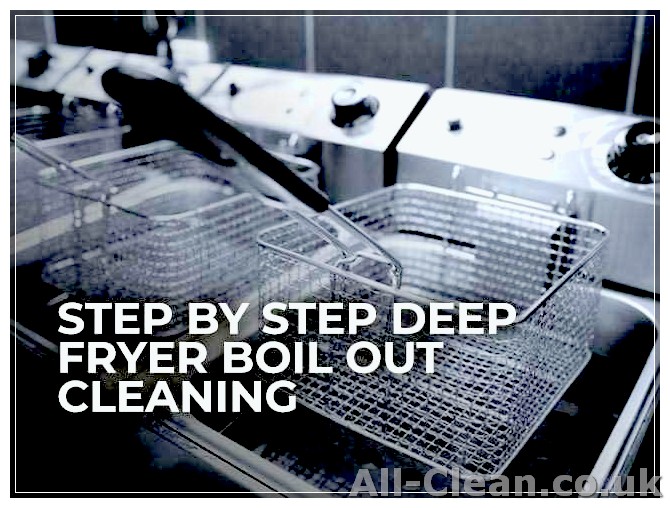
Keeping a commercial deep fryer clean is crucial for maintaining its performance and ensuring the quality of the food it produces. Regularly cleaning your deep fryer can also extend its lifespan and prevent expensive repairs. In this step-by-step guide, we will show you how to deep-clean your commercial deep fryer and get it back to optimal working condition.
Before you start, make sure the fryer is completely cooled down and unplugged. Drain the oil from the fryer and remove any food particles or debris that may have collected inside. It’s necessary to clean the fryer without any oil or items in it.
First, remove the fryer baskets and any other removable parts, such as the screens or wire racks. These items can be soaked and cleaned separately. Use a grease-cutting agent or a mixture of warm water and dish soap to wash all the removable parts. Rinse them thoroughly and allow them to air dry.
Next, it’s time to clean the inside of the deep fryer. Fill a sink or large basin with warm water and add a small amount of dish soap or vinegar. Using a cloth or sponge, wash the inside of the fryer, paying extra attention to any stuck-on grease or residue. Be sure to scrub all surfaces, including the bottom of the fryer where oil can accumulate. Rinse the fryer thoroughly with clean water, making sure to remove all soap or vinegar residue.
If your deep fryer has a drain, it’s important to remove any oil or water that may have collected. Some deep fryers have a valve or spout specifically designed for draining. If your fryer doesn’t have a drain, you may need to use a scoop or ladle to remove the liquid. Be careful not to pour hot liquid down the drain, as it can cause clogging or damage.
Once the fryer is clean and dry, it’s time to reassemble the removable parts and get it ready for use again. Make sure all parts are placed back in their correct positions. Before adding fresh oil, double-check that the temperature knob is set to the “off” position.
Congratulations! You have successfully deep-cleaned your commercial deep fryer. Remember to regularly clean and maintain your fryer to ensure the best frying quality and prolong its lifespan. By following this step-by-step procedure, you can keep your fryer in top condition and say goodbye to any stuck-on grease or other issues.
- Safety Precautions for Cleaning a Commercial Deep Fryer
- 1. Turn off and unplug the fryer
- 2. Allow the fryer to cool down
- 3. Extinguish any open flames
- 4. Use protective equipment
- 5. Drain and clean the fryer regularly
- 6. Utilize proper cleaning utensils
- 7. Clean the fryer basket
- 8. Clean the frying pot and bottom
- 9. Check for leaks or spills
- 10. Follow manufacturer’s recommendations
- Gathering the Necessary Supplies for Cleaning a Commercial Deep Fryer
- Tips for Gathering Supplies
- Draining and Removing the Oil from a Commercial Deep Fryer
- Cleaning the Interior and Exterior of a Commercial Deep Fryer
- Cleaning the Interior
- Cleaning the Exterior
- Preventing the Burning of Oil with a Potato
- The Process
- How Does It Work?
- Important Tips
Safety Precautions for Cleaning a Commercial Deep Fryer
When it comes to cleaning a commercial deep fryer, safety should always be a top priority. Follow these safety precautions to ensure a safe and effective cleaning process:
1. Turn off and unplug the fryer
Before starting the cleaning process, make sure the fryer is turned off and unplugged. This will prevent any accidents or injuries caused by heat or electrical shocks.
2. Allow the fryer to cool down

Deep fryers operate at very high temperatures, so it’s important to allow them to cool down before cleaning. Wait for the fryer to reach room temperature to avoid burning yourself during the cleaning process.
3. Extinguish any open flames
If your deep fryer is located in a commercial kitchen, make sure to extinguish any open flames before cleaning. This includes turning off nearby stoves or grills to minimize the risk of fire.
4. Use protective equipment
Wear protective gloves and goggles to protect your hands and eyes from any chemicals or hot oil that may splash during the cleaning process.
5. Drain and clean the fryer regularly
Cleaning a deep fryer should be done regularly, especially in commercial settings. Empty the fryer of any oil or grease and clean the interior and exterior surfaces of the fryer using a mild dish soap and warm water.
6. Utilize proper cleaning utensils
Use non-abrasive cleaning utensils, such as soft brushes or sponges, to avoid damaging the fryer’s surfaces. Avoid using sharp or metal tools that may scratch or puncture the fryer.
7. Clean the fryer basket
Remove the fryer basket and clean it separately. Soak it in warm soapy water to remove any stuck-on food particles, then rinse it thoroughly before placing it back into the fryer.
8. Clean the frying pot and bottom
Clean the frying pot and the bottom of the fryer using a cleaning solution of warm water and vinegar. This will help degrease the surfaces and remove any stubborn stains or debris.
9. Check for leaks or spills
Before using the fryer again, check for any leaks or spills that may have occurred during the cleaning process. If you notice any, fix the issue and clean up the spills promptly to prevent accidents or damage.
10. Follow manufacturer’s recommendations
Always follow the manufacturer’s recommendations for cleaning and maintaining your commercial deep fryer. These recommendations may include specific cleaning products or procedures that are necessary for optimal performance and safety.
By following these safety precautions and regularly cleaning your commercial deep fryer, you can ensure its longevity and maintain the quality of your fried food. Happy cleaning!
Gathering the Necessary Supplies for Cleaning a Commercial Deep Fryer
Before you start cleaning a commercial deep fryer, it’s important to gather all the necessary supplies. Having everything on hand will make the cleaning process smoother and more efficient. Here’s a list of recommended supplies:
- Protective gloves
- Apron
- Hot water
- Dish soap
- Sponge/scrubber
- Baking soda
- Vinegar
- Paper towels
- Lint-free cloth
- Bucket
- Strainer
- Filtering equipment
- Cleaning brush
These supplies will help you tackle different aspects of the deep fryer cleaning process, from removing grease to scrubbing surfaces. It’s always best to follow the manufacturer’s recommendations for cleaning and maintenance, as each fryer may have specific requirements.
Tips for Gathering Supplies
Here are some tips to help you gather the necessary supplies for cleaning a commercial deep fryer:
- Check if your establishment has a specific cleaning service or protocol in place for deep fryers. If so, follow their guidelines.
- Ask any questions you may have about the cleaning process beforehand, so you don’t get stuck or accidentally damage the fryer.
- If this is your first time cleaning a deep fryer, consider asking an experienced colleague for guidance or tips.
- Always wear protective gloves, as cleaning solutions and stuck-on grease can be difficult to remove without them.
- Make sure the fryer is completely cooled down before starting the cleaning procedure to avoid burns or injuries.
- Keep a track of the parts you remove during the cleaning process for easier reassembly later.
- If you’re unsure about the best way to clean certain parts, consult the fryer’s manual or contact the manufacturer for further instructions.
By gathering all the necessary supplies and following these expert tips, you’ll be well-prepared to clean a commercial deep fryer and maintain its quality for great frying results every time.
Draining and Removing the Oil from a Commercial Deep Fryer
One of the key steps in cleaning a commercial deep fryer is draining and removing the oil. This process can be challenging, as the majority of the oil must be removed so that the fryer can be thoroughly cleaned and maintained. Here are some tips and tricks to help you complete this step effectively:
- Allow the oil to cool: Before draining the oil, it’s important to allow it to cool down to a safe temperature. This will help prevent any burns or accidents during the cleaning process.
- Gather the necessary supplies: You will need supplies such as a bucket or receptacle for the old oil, a fryer brush, a soft cloth or sponge, and a suitable cleaning agent.
- Remove the fryer basket: Take out the fryer basket and set it aside. This will make it easier to access the oil and clean the fryer.
- Drain the oil: Locate the drain valve or spigot on the fryer and open it. This will allow the oil to flow out into the bucket or receptacle. Be sure to drain all of the oil from the fryer, as leaving any residue behind can lead to build-up and impact the quality of your fried products.
- Utilize a fryer brush: Once the oil has drained, use a fryer brush to remove any remaining bits of food or grease that may be stuck to the fryer walls or heating element.
- Wipe down the fryer: Take a soft cloth or sponge and dampen it with a suitable cleaning agent. Carefully wipe down the inside and outside surfaces of the fryer, paying close attention to any spills or sticky areas.
- Rinse with water: After wiping down the fryer, rinse the surfaces with water to remove any remaining cleaning agent.
- Dry thoroughly: Use a clean cloth to dry the fryer, both inside and outside. Make sure there is no moisture left behind, as this can lead to rust or other damage.
- Inspect and reassemble: Before using the fryer again, inspect all parts to ensure they are clean and in good condition. Reassemble the fryer, including placing the fryer basket back into position.
- Dispose of the oil: Properly dispose of the old oil according to local regulations. Many establishments utilize grease collection services or recycling programs.
Note: It’s recommended to clean a commercial deep fryer at least once a week to maintain its performance and prevent build-up. However, the frequency may vary depending on the level of usage. Consulting the fryer’s user manual or seeking advice from cleaning experts can be useful for establishing a regular cleaning and maintenance routine.
Cleaning the Interior and Exterior of a Commercial Deep Fryer

Cleaning the Interior

Cleaning the interior of a commercial deep fryer is essential for maintaining its performance and safety. Follow these steps to effectively clean the inside of the fryer:
- Turn off the fryer and allow it to cool down to a safe temperature.
- Use a wire fryer basket or a skimmer to remove any leftover food particles or debris from the oil.
- Wait for the oil to cool down completely before draining it out. This can be done by opening the drain valve and transferring the oil to a suitable container.
- Wipe down the interior surfaces of the fryer with a sponge or cloth soaked in a commercial degreaser or a mixture of warm water and dishwashing detergent.
- Rinse the interior surfaces with clean water and wipe them dry with a clean cloth.
- For stubborn grease or stuck-on residue, you can use a paste made from baking soda and water. Apply the paste to the affected areas, let it sit for a few minutes, and then scrub it off with a non-abrasive scrub brush or sponge.
- Once the cleaning is done, thoroughly rinse the fryer with clean water and wipe it dry.
Cleaning the Exterior
The exterior of a commercial deep fryer also requires regular cleaning to maintain its appearance and prevent grease buildup. Here’s how to clean the exterior:
- Make sure the fryer is turned off and properly cooled.
- Use a damp cloth or sponge to wipe down the exterior surfaces of the fryer, removing any grease or stains.
- If there are any sticky or stubborn spots, use a mixture of warm water and dishwashing detergent to clean them.
- Dry the exterior surfaces with a clean cloth.
- If your fryer has stainless steel panels, you can use a stainless steel cleaner to restore their shine.
Cleaning a commercial deep fryer’s interior and exterior regularly is essential to prevent issues such as stuck-on grease, reduced performance, and fire hazards. By following the proper cleaning procedures and using effective cleaning supplies, you can keep your fryer in good condition and prolong its lifespan.
Preventing the Burning of Oil with a Potato

One of the biggest concerns when it comes to deep frying is preventing the burning of oil. This can be a particularly common issue in commercial deep fryers, where the fryer is being used for long periods of time and the oil can become overheated.
To prevent oil from burning and extending the life of your fryer, there is a simple and useful trick you can try: using a potato. Yes, a potato!
The Process
- Before you start, make sure the fryer is turned off and the oil has cooled down.
- Take a potato and wash it thoroughly. Make sure to clean it well to remove any dirt or debris.
- Cut the potato into wedges or thick slices. The size will depend on the size of your fryer, but they should be large enough to effectively absorb the excess heat.
- Once your potato slices are ready, simply add them to the frying oil.
- Turn on the fryer and fry the potato slices until they turn golden brown.
- Remove the potato slices from the fryer and dispose of them.
How Does It Work?
The potato acts as a natural heat sink. It absorbs the excess heat and prevents the oil from reaching a dangerously high temperature, thus preventing it from burning. As the potato slices fry, they become saturated with hot and greasy oil, so make sure to remove them from the fryer and dispose of them properly.
This simple trick can help you prevent oil from burning and extend the life of your commercial deep fryer. It’s an easy and safe way to maintain the temperature of the oil and avoid any potential risks.
Important Tips
- Remember to complete a routine inspection of your fryer before and after each use.
- Regularly clean and deep-clean your fryer to keep it in good condition.
- Always follow the manufacturer’s instructions when cleaning or repairing your fryer.
- If you notice any leaks or other issues with your fryer, contact a professional technician to have it inspected and repaired.
- Keep in mind that using a wire screen or a drip tray can help filter out any loose or hardened particles and keep the oil clean.
- Don’t forget to wipe down the exterior of the fryer to remove any greasy or sticky residue.
- If you’re unsure about how to clean or maintain your fryer, don’t hesitate to seek advice from experts or consult the user manual.
By following these tips and using the potato trick whenever necessary, you can ensure that your commercial deep fryer stays in good working condition and provides you with delicious fried foods time and time again.








